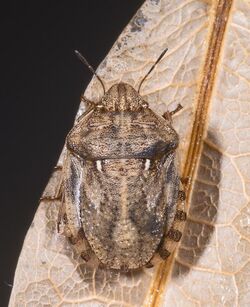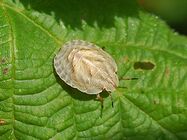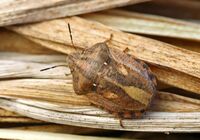Biology:Eurygaster maura
| Eurygaster maura | |
|---|---|

| |
| Eurygaster maura, adult | |
| Scientific classification | |
| Kingdom: | |
| Phylum: | |
| Class: | |
| Order: | |
| Suborder: | |
| Family: | |
| Genus: | |
| Species: | E. maura
|
| Binomial name | |
| Eurygaster maura | |
| Synonyms[1] | |
|
List
| |
Eurygaster maura, also known as tortoise bug,[2] is a species of true bugs or shield-backed bugs belonging to the family Scutelleridae.
Distribution
This species is widespread in Europe,[3] but also in large parts of Asia and North America.[4]
Habitat
Their habitats are calcareous grasslands with wild grasses.
Description
Eurygaster maura can reach a length of 8–11 millimetres (0.31–0.43 in).[5][2] The body is oval and slightly convex and the head is triangular and smoothly rounded, with a small pair of compound eyes. The pronotum has slightly protruding hind corners. The scutellum covers the wings and the whole abdomen. The ground color is mostly brown, but can be light gray or also black.[2][5]
This species is rather similar to Eurygaster testudinaria, but it is slightly smaller and smoothly rounded, with less protruding hind corner.[2]
Biology
Eurygaster maura is a univoltine species. These shield-backed bugs can be found from May to August, becoming adult from July.[2] The females lay their eggs in the spring in small packages on the underside of the leaves surface. After a few weeks the eggs hatch the young nymphs. After five molts, they are fully developed and ready to overwinter in leaf litter.[5]
E. maura is a sunn pest - both the adults and their larvae are very harmful to crops.[6] They feed on various grasses[5][2] and grain plants (wheat, rye, barley and sometimes oats, corn and millet).[6] Blandino et al 2015 find the Mixolab test to provide accurate data about the effects of E. maura damage, insecticide application, fungal pathogens vectored by the pest, and fungicide application, on both common wheat and durum.[7][8]
Gallery
See also
- List of shield bug species of Great Britain
References
- ↑ Biolib
- ↑ 2.0 2.1 2.2 2.3 2.4 2.5 British Bugs
- ↑ Fauna Europaea
- ↑ Ekkehard Wachmann, Albert Melber, Jürgen Deckert: Wanzen. Band 4: Pentatomomorpha II: Pentatomoidea: Cydnidae, Thyreocoridae, Plataspidae, Acanthosomatidae, Scutelleridae, Pentatomidae. - Goecke & Evers, Keltern 2008, ISBN:978-3-937783-36-9
- ↑ 5.0 5.1 5.2 5.3 Insekten Box (in German)
- ↑ 6.0 6.1 Economic Plants and their Diseases
- ↑ Alconada, T. M.; Moure, M. C.; Ortega, L. M. (2019-08-26). "Fusarium infection in wheat, aggressiveness and changes in grain quality: a review". Vegetos (Springer) 32 (4): 441–449. doi:10.1007/s42535-019-00054-z. ISSN 2229-4473.
- ↑ Parenti, Ottavia; Guerrini, Lorenzo; Mompin, Sara Bossa; Toldrà, Mònica; Zanoni, Bruno (2021). "The determination of bread dough readiness during kneading of wheat flour: A review of the available methods". Journal of Food Engineering (International Society of Food Engineering (Elsevier)) 309: 110692. doi:10.1016/j.jfoodeng.2021.110692. ISSN 0260-8774.
External links
Wikidata ☰ Q1500657 entry
 |





